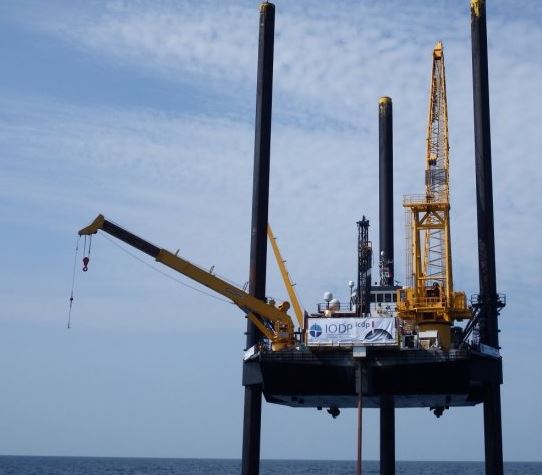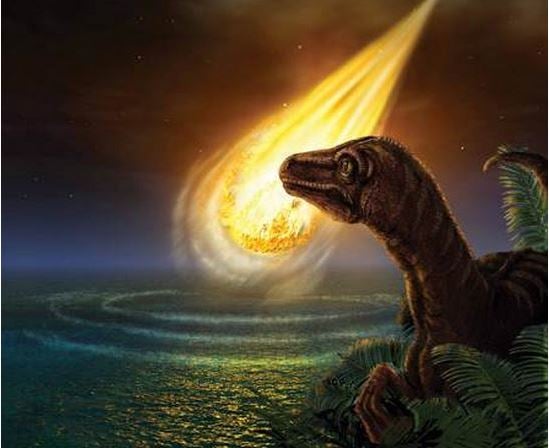The killer asteroid that struck the Earth 65 million years ago and triggered the extinction of the dinosaur and 75% of all life on our planet, did so with incredible force, say scientists from Imperial College London in a new study. Ironically, it probably also helped simple organisms emerge and thrive.
The researchers, whose findings have been published in the prestigious journal Science (citation below), said their new work confirmed that the killer asteroid which created the Chicxulub crater off the coast of what is now Mexico, hit with such a force that it pushed rocks incredible distances.
 The researchers used a platform to drill into rocks far below the seafloor. (Image: imperial.ac.uk)
The researchers used a platform to drill into rocks far below the seafloor. (Image: imperial.ac.uk)
Killer asteroid punctured Earth’s crust
The asteroid pushed rocks, which were then 10 kilometres (6.2 miles) below the Earth’s surface, further downwards and then outwards. After being displaced, they moved inwards again towards the impact site and then up to the surface, before collapsing downwards and outward again, forming a the peak ring.
In a matter of a few minutes, the rocks moved a total distance of about 30 kilometres (18.6 miles).
The scientists said their study showed how large asteroid impacts can deform rocks in a way that may produce ideal habitats for early life to thrive.
In April and May this year, an international team of scientists – from the UK, USA, France, Belgium, Australia, Austria, Germany, Japan, China, Canada, Mexico, and the Netherlands – went on an offshore expedition and drilled into part of the Chicxulub impact crater. They wanted to retrieve samples from the crater’s rocky inner ridges – the ‘peak ring’.
 A cross-section of one of the core samples. (Image: imperial.ac.uk)
A cross-section of one of the core samples. (Image: imperial.ac.uk)
They drilled from 506 to 1,224 metres (1,660 to 4,015 feet) below the sea floor in order to gain a better understanding about exactly what happened during and after the ancient cataclysmic event.
Killer asteroid made rocks more porous
Lead author, Professor Joanna Morgan, who works at Imperial’s Department of Earth Science and Engineering, and colleagues say they carried out the first analysis of the core samples. Their findings showed that the killer asteroid all those millions of years ago deformed the peak ring rocks in such a way that they became considerably more porous and less dense than they had ever predicted from their simulated models.
Porous rocks provide ideal niches for simple organisms to take hold and then thrive. Inside the pores there would have been nutrients deposited from the circulating water that would have been heated inside the Earth’s crust.
In an Abstract preceding the main paper in the journal, the authors wrote:
“Expedition 364 sampled the Chicxulub peak ring, which we found was formed from uplifted, fractured, shocked, felsic basement rocks. The peak-ring rocks are cross-cut by dikes and shear zones and have an unusually low density and seismic velocity. Large impacts therefore generate vertical fluxes and increase porosity in planetary crust.”
 The killer asteroid that triggered the destruction of 75% of all life on Earth, including the dinosaur, also made the rocks in the impact area more porous, which made it easier for simple organisms to take hold.
The killer asteroid that triggered the destruction of 75% of all life on Earth, including the dinosaur, also made the rocks in the impact area more porous, which made it easier for simple organisms to take hold.
Young Earth was constantly bombarded
When the Earth was younger, it was constantly bombarded by asteroids and comets. The researchers have inferred that this bombardment probably also created other rocks with similar porous qualities. This might partly explain how life first gained a foothold here on our planet.
Professor Morgan commented on the irony of the killer asteroid, which also probably played a part in helping simple organisms to develop:
“It is hard to believe that the same forces that destroyed the dinosaurs may have also played a part, much earlier on in Earth’s history, in providing the first refuges for early life on the planet.”
“We are hoping that further analyses of the core samples will provide more insights into how life can exist in these subterranean environments.”
Rock core from dinosaur-killing impact reveals how enormous craters form https://t.co/hxpIz3SrFF #Chicxulub pic.twitter.com/gaBbEfBuxg
— Nature News&Comment (@NatureNews) November 17, 2016
Prof. Morgan and colleagues now plan to acquire a whole collection of detailed measurements from the recovered core sample to refine their simulated models. Their ultimate aim is to find evidence of ancient and modern life in the peak-ring rocks.
They would also like to find out more about the first sediments that settled on top of the peak ring, which could tell them whether they were deposited by a giant tsunami. The core samples may also help them determine when life actually returned to this sterilized region after the killer asteroid struck.
Citation: “The formation of peak rings in large impact craters,” Joanna V. Morgan, Sean P. S. Gulick, Gordon R. Osinski, Ligia Perez-Cruz, Timothy Bralower, Michael Whalen, Axel Wittmann, Kosei E. Yamaguchi, Elise Chenot, Gail Christeson, Philippe Claeys, Charles Cockell, Sonia Tikoo, Naotaka Tomioka, Jaime Urrutia-Fucugauchi, Gareth S. Collins, Marco J. L. Coolen, Ludovic Ferrière, Catalina Gebhardt, Kazuhisa Goto, Heather Jones, David A. Kring, Erwan Le Ber, Honami Sato, Douglas R. Schmitt, Jan Smit, Johanna Lofi, Xiao Long, Christopher Lowery, Claire Mellett, Rubén Ocampo-Torres, Annemarie Pickersgill, Michael Poelchau, Auriol Rae, Cornelia Rasmussen, Mario Rebolledo-Vieyra, Ulrich Riller, & William Zylberman. Science 18 Nov 2016: Vol. 354, Issue 6314, pp. 878-882. DOI: 10.1126/science.aah6561.
Video – Killer asteroid impact simulation
This video, by the Institute for Geophysics, Jackson School of Geosciences, University of Texas at Austin, is of a computer model simulating how the Chicxulub crater was formed when the asteroid struck. The light grey represent’s the Earth’s crust, while the dark grey represents the upper mantle.
